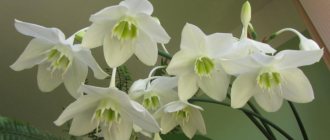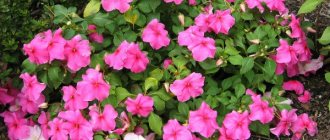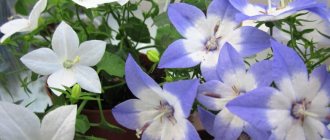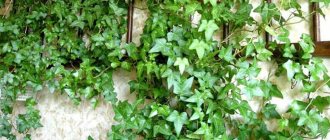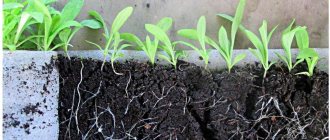General description of the balsam plant
Balsam was brought to Europe and then to Russia at the end of the 18th century and immediately gained great popularity.
The family to which this indoor flower belongs includes more than 500 varieties. These plants are native to South America, Africa and India. Here, in subtropical conditions, balsams receive a sufficient amount of moisture and sunlight. However, no more than 8 species of these plants can live at home. At the same time, two natural varieties of balsam, distinguished by white and red flowers, have become widespread. In addition, about 200 varieties of these plants have been bred under artificial conditions, the color diversity of which is great.
The indoor balsam flower is small in size. It grows in the form of a small bush, reaching no more than 60 cm in height. The balsam bush has a spherical shape. The stems of the plant are thick and succulent. They are fragile and brittle.
Only 8 species can grow in temperate climates. And 15 were brought into culture.
The plant produces many leaves, characterized by an elongated, rounded shape. The length of the leaves does not exceed 7 cm. In some varieties of this plant, the leaves may be heart-shaped. Their color can vary from light to rich dark green. There are many denticles along the edge of the leaves. There may be a small thorn at the tips. Veins are clearly visible on the leaves, distinguished by a darker shade.
The root system of balsam has a fibrous shape. She's not very well developed. With proper care, the plant blooms almost throughout the year. Each flower has 5 petals. They can have bizarre shapes, hang freely or be fused in pairs. Flowers can grow individually or be collected in large inflorescences.
There are varieties of balsam that produce double and semi-double flowers. In addition, there are plants with two-color flowers. Different varieties may differ in the shape of the buds. They can be camellia-shaped, carnation-flowered, fringed. There are plants whose buds resemble roses. After the flowering period ends, the petals fall and green fruits are formed, which subsequently dry out. The fruits contain from 3 to 5 seeds.
Description and other names
Impatiens is a plant that quickly takes root and grows well in a pot. Flower growers choose the crop due to its constant growing season and ease of care. In its natural environment, the flower lives in a subtropical climate. It can also be found in the USA, India and Africa.
The varieties that have become widespread in Russia have brittle and succulent stems, about 0.5 m long. The root system is fibrous. The leaves are oval or heart-shaped, 7 cm long. At first they narrow and widen near the stem. The edges are jagged, with a spine at the end.
Russian gardeners grow balsam in a pot with light green or rich green leaves. There are also varieties with dark green foliage, the tint of which is brown or lilac. The veins are clearly visible on the leaf, which are slightly lighter than the leaf plate.
The culture has flowers with five petals. They come in pink, red, pale pink. Some varieties look interesting thanks to their two-tone color and double or semi-double petals. After flowering, the buds produce green fruits, which, when ripe, create a capsule.
Balsam has other names. So, it is also called Touchy, because during the ripening of the seeds, the fruit boxes immediately crumble, as soon as you touch them. The flower was also nicknamed the Light. It received this name due to the wide variety of shades of flowers, which open in the evening and resemble lights.
Another unusual name is Vanka wet. It comes from the fact that the plant constantly needs watering. And after irrigation or before bad weather, sugary dew is released on the edges of the leaves.
Popular varieties and types of balsam
There are many varieties of this indoor flower. They can be annual or perennial. The fundamental difference between the varieties is the color of the buds and the splendor of flowering.
Wallera is a variety of balsam that served as the basis for the development of many other hybrids. It grows up to 50 cm in height. During the flowering period, it produces large pink-white flowers.
New Guinea balsam.
Waller's balsam.
New Guinea balsam is distinguished by green leaves with bright yellow veins. The plant produces large flowers of bright colors. This variety can be grown in open ground.
Orchid balsam has a thick red stem that is distinguished by a dark pink color. The leaves are large. Their veins are also dark pink, the surface is velvety. Flowers are deformed. They are shaped like shoes.
Strawberries with cream – (terry variety of balsam.
Orchid balsam.
Strawberries with cream - indoor terry variety Balsamina. It is characterized by red and white flowers up to 4 cm in diameter. A very spectacular variety with a lush crown and long flowering even in low light conditions.
Salmon Chiffon is characterized by long flowering, during which the plant produces large, bright buds. The petals have a rough surface. This variety is whimsical.
Balsam Salmon Chiffon.
Kandy (Candy).
Kandy is a relatively recently developed variety. It is distinguished by the presence of dark oblong leaves. The plant blooms profusely. The buds are dense and have high stalks. The petals are velvety and soft to the touch. Flowers can have different colors.
Cutie is a beautiful small bush. It produces a large number of small leaves and produces pink, red and white flowers. It can bloom all year long.
The universal varietal mixture blooms beautifully in interiors all year round and in flower beds in summer.
Boy with a Thumb - A beautiful and abundantly flowering bush of a compact size with branched stems and bright, double large flowers. It can be grown as an indoor flower or in open ground. One bush can have flowers of white, red and pink. This variety loves sunny places, but is able to grow and bloom in partial shade and even in the shade, where its branches and flowers will be smaller. The flower should be watered abundantly, as it does not tolerate drying out of the soil. To make the bush more branchy, its tops need to be pinched. Indoor Balsam can grow in a cramped pot. In open ground, the size of the flower will undoubtedly be large.
Tom Thumb.
Peters.
Peters - this species is distinguished by the color of the foliage - it has a bronze tint. Blooms profusely with bright red flowers.
What is Balsam
Since 1596, Europe began to be filled with a flower with a cute appearance, becoming popular throughout the world. Impatiens are valued for their ability to bloom almost all the time, without requiring much care. In addition, it can be easily propagated.
Depending on the variety, the height of the plant can be from 0.15 to 0.5 meters. On branched strong stems there is fleshy foliage with a wavy edge. It is colored green with a red tint. There are also varieties with bronze and green leaves. The peculiarity of this plant is that drops can collect at the ends when the humidity level rises. Most likely, it is because of this phenomenon that Balsam is popularly called Vanka-wet.
The flowers are located inside the leaf axils and the variety of their colors is very great. For example, there are red, pink, orange, purple, white. Their surface can still be decorated with stripes and spots. In addition, there are terry leaves and multi-colored ones. Most varieties have miniature flowers. But it is precisely because of their bright color that they look attractive, and the plant is sometimes called “Balsam Light”.
After the flowering period, green fruits begin to develop. By the end of its ripening, it turns into a box with seeds. With a light touch it can explode, scattering seeds. It is thanks to this feature that the plant is also called “Impatiens impatiens”.
Impatiens can be either perennial or annual. The first varieties are used to decorate rooms, and the second - for balconies and gardens. To create a flower bed, it is recommended to use frost-resistant varieties whose flowering period lasts from spring until the first frost.
Impatiens is a suitable flower for rooms where children are. For example, it can be placed in schools, kindergartens, etc.
How to care for balsam
Impatiens are not very demanding plants and are quite easy to care for, so novice gardeners are happy to plant them. These flowering plants are heat-loving, light-loving (but do not tolerate direct sunlight) and do not like drafts.
For example, Waller's balsam (Impatiens walleriana), a species that is used for home breeding, can be called universal. They can easily tolerate short-term drying out of the soil and quickly recover immediately after watering. But they do not like overheating and waterlogging.
Location and lighting
This rather unpretentious plant feels great both on the windowsill and in those places in the room where there is enough diffused light. This allows you to use a flowering plant as an elegant decorative element.
A pot of balsam is most often placed on the east or west side, but even on the north window the light develops and blooms well. If it lives on a south window, it is necessary to consider protecting the bush from the sun's rays.
Elegant New Guinea hybrid varieties require more intense light.
Important: during the hot period, the impatiens must be protected from direct sun, shaded, or temporarily moved to another place. But in winter, for continuous flowering, it needs “sunbathing”.
Temperature
Impatiens are comfortable in the temperature range from 180 to 250. If the humidity in the room is high, then it tolerates higher temperatures well.
In winter, with sufficient lighting and proper watering, the plant can be kept in a room with temperatures up to +120. With prolonged hypothermia, the fire can shed its leaves.
Humidity
Indoor types of balsam feel most comfortable in rooms with moderate humidity (40-50%). In a warm room with high humidity, these flowers also develop well and bloom well.
But a long stay in a dry environment can cause the tips of the leaves to begin to turn yellow, and the buds and flowers to fall off.
Humidity can be increased by placing a pot of impatiens on damp expanded clay or placing a container of clean water next to the balsam.
It is recommended to periodically rinse or spray the leaves of impatiens with clean warm water (250). It is important to ensure that droplets of water do not fall on already blooming flowers.
Watering mode
It is not for nothing that people call balsam Vanka-wet - it is a moisture-loving plant, but maintaining water balance is very important for it.
Droplets of a sweetish liquid are released on the stems of balsam and along the edges of the leaves - this is how the plant independently protects itself from excess moisture.
The soil in a pot of impatiens should always be moist. However, the amount of water must be selected so that it does not stagnate and does not fill the container (tray) under the pot. In winter, the plant is watered less intensively.
Top dressing
From spring to autumn, balsam must be fed regularly (about once every 14 days) with liquid complex fertilizers intended for flowering plants. Such nutritional mixtures are sold in flower shops.
During the cold period, fertilizing begins only after the formation of flower buds.
With insufficient nutrition, the stems quickly lengthen, the leaves turn pale and become smaller.
Replanting and pruning
This houseplant must be replanted annually. The best time is spring.
Indoor balsam is not very picky about soil. For this, plants often use a loose mixture, which is prepared from leaf soil, peat, sand, taken in a ratio of 2:1:1 . You can add some charcoal to the mixture.
For the now popular New Guinea varieties, soil is prepared from equal parts of turf, nutritious humus, compost, and baking powder (perlite).
The flower pot for balsam should correspond to the size of its rhizome. In spacious containers, the plant, as a rule, does not bloom.
Balsam propagation
Indoor balsam can be propagated without any problems either by seeds or by cuttings.
- Seeds. After flowering, the impatiens produce green fruits that look like boxes. A ripe dry box “explodes” upon touch, shooting out small grains. They are sown in a mixture of peat and perlite to a depth of approximately 0.7–0.9 centimeters. After sowing, the soil must be moistened. The container with seeds must be “insulated”, creating a zone with a temperature of about 25°. To do this, just cover it with a transparent plastic bag. The seedlings should “hatch” in 10–12 days. When the seedling has formed one leaf, it is transplanted into a clean pot. Impatiens bloom 3–4 months after sowing.
- Cuttings. The plant is propagated by stem and apical cuttings. This method is especially relevant for propagating elegant terry balsams. The top of the cutting (about 6–7 centimeters) is carefully cut off with a sharp knife or scalpel. There should be several internodes on the cutting. The lower leaves are removed. The prepared cuttings are planted in a nutrient substrate, which is prepared from vermiculite, peat and perlite (in equal parts). After this, you need to compact the soil around the cuttings, pour warm water in which you first dissolve a little potassium permanganate. In a few days, roots will form. Plants obtained from spring cuttings bloom in summer. In order for the plant to bloom in winter, the cuttings are planted in July-August.
Impatiens growth rate
Impatiens manifests itself as a fast-growing plant if you strictly adhere to the agricultural techniques of growing a flower in caring for it: observe temperature and humidity conditions, replant annually in larger containers, water in a timely manner, apply fertilizers, etc.
The determining role in the growth rate of a pet is played by its appearance. Recently, breeders have developed dwarf forms of the plant up to 15 cm high, as well as low-growing hanging varieties that grow horizontally up to 40–60 cm.
Traditional flower forms, for example Waller's balsam, reach 60–80 cm in height and already 90–100 days after emergence they delight the eye with their friendly flowering.
Lifespan
The balsam family includes both perennial plants and annuals , the life cycle of which occurs within one year.
Many florists prefer to grow even recognized centenarians of the genus Impatiens in annual culture, planting them in separate pots and placing them on flower beds, balconies, open terraces or rooftops. If it is intended to cultivate impatiens as a perennial, then it is pruned every spring.
One of the equally important procedures for care and cultivation is propagation and planting (transplantation), about which our specialists have prepared interesting materials.
Growing conditions in the apartment
The rules for caring for balsam are common to all types that can be bought in the store. It is important to achieve lush flowering. In order for the plant to please with flower stalks, you need to remember the following points:
- Impatiens do not like dry soil.
- The lighting should be bright, but it is advisable to organize shading on the south window.
- Bushes love ventilation, but do not tolerate drafts well.
- For planting and replanting, it is better to choose a pot 2–3 cm larger than the previous one, so that the roots do not grow to the detriment of flowering.
- If possible, when caring at home, it is advisable to plant wet Vanka in open ground in the summer, and back in the pot in the fall.
The plant propagates well by cuttings, while maintaining varietal characteristics. It is not recommended to collect the seeds of hybrids - ordinary balsams grow from them.
Lighting
In summer, Tropicans prefer at least 12 hours of light. For this, a south window is more suitable for them. If the species does not feel well under the influence of direct rays, it needs to be shaded with a curtain or blinds.
In winter, balsams, especially those that bloom year-round, need to be illuminated with a phytolamp, otherwise the buds will fall off and yellowing ones will appear among the leaves. 12 – 14 hours of lighting is the norm for this plant.
If you buy a flower in a store, you need to take into account that it was grown in a lot of light. With a sharp decrease in lighting, the stems and leaves will begin to wither and the leaves will fall off. It is better to immediately place it on the south side and observe how it feels.
Newly transplanted specimens or cuttings must be shaded. Nutrition of the tissues has not yet been established, so the flower may get burned and not recover.
You can keep plants on the eastern windowsill in the summer and move them to the southern one in winter. Vanka wet will not bloom in a dark place.
Temperature
During the flowering period and the active phase of the growing season, balsam needs warmth. It feels good at 20 – 28 degrees. If the temperature rises higher, it is necessary to mist the plant daily to increase evaporation.
When the plant has finished blooming and is preparing for hibernation, you need to organize a room with a temperature of at least 16 degrees, since the flower does not tolerate cold well. Roots in wet soil begin to rot, and in dry soil the crop dies.
Some species do well in the sun, but they should be acclimated to the heat little by little. It is better to plant them in open ground in the shade of trees.
The soil
The store sells soil for flowering plants - it is great for impatiens. It is important that the soil has good air permeability. When preparing the soil mixture at home, sand and peat are added to the loams for looseness.
The acidity should be weak; for this, one part of red peat to 1 part of compost, turf soil, humus and sand is enough. You can add perlite or vermiculite, and add expanded clay drainage to the bottom of the pot.
To avoid infection, the soil is steamed, then pieces of activated charcoal or charcoal are added.
You can make holes in the garden by mixing soil with sand and humus.
Feeding
For flowering plants, fertilizing should consist of potassium and phosphorus. This stimulates bud setting. Mineral complex fertilizers with a small amount of nitrogen are suitable. You should also not add a lot of compost to the soil, because this will lead to an increase in green mass.
Superphosphate, potassium nitrate, potassium magnesia, potassium sulfate are suitable fertilizers for flowering balsam. In order not to calculate the amount of minerals yourself, it is better to use purchased mixtures.
From April to mid-autumn, balsams are fed twice a month. During the dormant period, the amount of fertilizer is reduced to a minimum or not applied at all.
For the first 2 months , you don’t need to fertilize if the plant is planted in new purchased soil. It will have enough nutrients until flowering begins.
Video: Growing and caring for balsam
Watering
The soil around the balsam roots should always be moist. It is not useful if there is more water than required - in this case, the root system will not be able to breathe. Dryness is harmful for succulent shoots - they lose turgor and droop.
Water is used from melt water, rain water or settled water if the flower grows in an apartment. Its temperature should be room temperature; cold liquid causes rotting of the roots.
To understand when to water the balsam, you need to pierce the top layer of soil 1 cm deep. If the soil is dry, you can water it.
If there are hardness salts in the water - calcium and magnesium - a white crust may appear on the surface. This begins the alkalization process, in which the absorption of phosphorus is disrupted (phosphates require a slightly acidic environment to break down). The crust must be carefully removed and replaced with new soil.
In order for the liquid to pass well through the soil, there must be a layer of drainage at least 2 cm below. An air gap is needed between the pan and the drainage holes - so the roots can breathe. Excess water when watering is drained.
An indicator of proper watering is the release of dew on the leaves after each moistening of the soil. The root collar should not get wet, otherwise a fungal infection begins and the flower dies.
Impatiens can be bathed by covering the soil with film. This procedure promotes better leaf respiration and chlorophyll production, as dust clogs the pores of the plant.
Soil and fertilizers
Impatiens are not too picky about the composition of the soil, but it is better if the soil is low in acidity. To prepare a soil mixture that will include all the necessary substances for the plant, it is necessary to mix leaf and turf soil, as well as sand and humus. These components should be taken in equal proportions. You can also add some peat to the mixture.
Periodically it is necessary to apply mineral fertilizers, ammonium sulfate and ammonium nitrate. It is recommended to fertilize in spring and autumn. It is especially important to apply fertilizers during the period of abundant flowering. You need to feed 2-3 times a month.
Photo
The following are photos on caring for and planting indoor balsam:
If you find an error, please select a piece of text and press Ctrl+Enter.
Pruning indoor balsam
Impatiens are pruned regularly throughout its life. If you grow Ogonyok from a seed, then as soon as the seven-lobed leaves appear, pinch the top of the central shoot. Then the side shoots will begin to develop, and the balsam will form a beautiful bush.
If you want to form a flower into a tree, wait until the stem of the young plant becomes woody. Then carefully cut off all the lower leaves and pinch the main shoot. Sprinkle the cut areas with crushed coal. Over time, form side shoots. After pruning, feed the plant with fertilizers (urea, vermicompost).
At the beginning of spring of any age, balsam should be pruned. Annual growth must be cut in half. By the way, the crown of Ogonyok should be formed throughout its entire growing season, namely, when young shoots reach the required length, the upper growth point should be pinched. This stimulates the formation of new side stems, on which bright buds and beautiful flowers will soon appear.
The need to prune balsam is associated with improving the appearance of the bush.
The appearance of Balsam is monitored all year round. Remove overgrown and weakened shoots, wilted flowers and leaves, cut off diseased parts of the plant that have lost their decorative properties. It is necessary to constantly maintain the decorative appearance of the flower. In order for Balsam to have a uniform, beautiful crown, the pot with the plant must be periodically rotated, exposing the flower to the sun from different sides. In addition, by constantly looking closely at the flower, you will not miss the onset of a disease or parasite attack.
Choosing a pot for indoor balsam
To grow Balsam, the size of the pot is important. The flower loves a small pot in which the root system has entwined the entire lump - this is an indispensable condition for the plant to bloom abundantly. If you plant Ogonyok in a spacious pot (like the one you happen to have at home), then it will spend all its energy growing the root system. This is how nature intended it - the roots of Balsam must completely entwine the lump of soil, only then will it be able to grow and form buds. That is, in a large pot you will wait longer for flowering. In addition, excess soil will turn sour with frequent watering, which will lead to root disease.
In addition to size, drainage holes at the bottom of the pot and the drainage itself are important, to which, in addition to expanded clay or pebbles, pieces of charcoal or activated carbon should be added to prevent diseases. To complete the set, you should purchase a deep tray so that excess water from it does not spill onto the windowsill.
Dormant period: caring for balsam in winter
How to preserve Balsam until next year? Balsam does not have a rest period in the usual sense. For several winter months it is forced to take a break from vigorous flowering, since there is not enough light for it to bloom fully. At this time, it is necessary to move the flower to a cooler room (16 - 18 degrees). Temperature is 10 degrees. is critical for Balsam.
In winter, you need to protect the plant from strong drafts.
Watering should be reduced, but just like in summer, it should be watered when the top layer of soil has dried to a depth of 1 cm. The soil should not be overdryed, as this can lead to weakening and delayed development of the flower. If the room is too dry and hot, you need to spray the air around the flower without spraying it onto the buds. It is better not to fertilize.
If you arrange additional artificial lighting for the flower using a phytolamp or a fluorescent lamp, then maintain other care items necessary for the flower - warmth, watering, fertilizing with liquid fertilizers once a month in a weak concentration. Then Ogonyok will delight you with its blooms all year round.
Disease Prevention
Hybridization of many types of balsam leads to an increased risk of diseases, not only in summer, but also in winter. Therefore, it is necessary to systematically inspect the leaf blades of the plant. If even one damaged stem is found, it can cause the death of the entire bush.
The flower is susceptible to invasion by aphids and whiteflies. The presence of spider mites that have settled on the shoots is the most dangerous negative. A sign of susceptibility is a thin network of cobwebs. The whitefly leaves white spots on the plates, accompanying the infection with slight leaf curling. Aphids can be recognized by brownish marks on the plates and the same curling pattern.
If traces of mold appear on the surface of the substrate, it is necessary to remove its top layer and then replace it with a new one.
Features of care in winter
How is balsam wintered? How to preserve balsam at home in winter? Let's consider the features of winter care at home.
How often to water a flower?
In autumn and winter, unlike in the summer, the intensity of watering must be reduced, waiting for the substrate to dry to a depth of 1 cm. However, the soil cannot be overdryed, since this is fraught with weak flowering and even falling buds, as well as slow growth and development of balsam.
Does the plant need to be sprayed?
In the cold season, you need to spray impatiens with extreme caution, avoiding water getting on the opened buds. The need for spraying is due to severe dry air and high room temperature - more than 22–25 ºС.
You can increase the humidity of the room air by placing containers of water next to the flower or placing the pot in plastic trays filled with moistened expanded clay, peat or moss.
Light mode
Balsam does not have a dormant period.
It can delight gardeners with its luxurious buds all year round, including in winter, but only with additional artificial lighting.
At low light intensity , it develops poorly, the leaves stretch, lose their usual color and fall off.
Which can ultimately lead to a complete loss of the plant’s aesthetic appeal.
Thermal mode
In winter, it is best to keep balsam at the lower limits of the temperature norm - 16–18 ºС, avoiding critical values - below 10 ºС.
Top dressing
Typically, fertilizing is not required in the cold season, but if the plant has blossomed in all its glory , then it would be useful to use complex fertilizers in low concentrations, the application of which is timed to coincide with watering.
When choosing a pet for your home greenhouse, you should not pass by balsam. Unlike its name – “touch-me-not” – the plant is amazingly unpretentious, and its unsurpassed beauty will not stop even the most sophisticated flower “gourmet” indifferent.
Care and maintenance
Before deciding on care, you need to know that balsam loves warmth and sun. Although, some varieties can grow well in partial shade.
If you have the opportunity, then choose a south-facing window for it. But remember, because the foliage is still sensitive to direct light, prolonged exposure to sunlight should be avoided.
The plant is placed where the sun's rays linger for a short time. If necessary, the location of the balsam is additionally shaded.
In cold winter times, make sure that the pot does not come into contact with the glass. Move it closer to the edge of the window sill, where there is most heat from the radiator. When ventilating the room, remove the flower from the window.
Maintaining humidity. Watering
Soil for balsam should always be kept moist. In winter, the volume of liquid when watering is reduced to 2/3.
Make sure that the water for irrigation is not hard and does not contain heavy impurities. In order for the water to be safe for the plant, it must be left for 2-3 days.
Impatiens need to be watered frequently. Just make sure there is no overwatering, otherwise the root system of the plant may be damaged. In case of constant overwatering, the roots begin to rot.
Indoor temperature and humidity
If you remember where balsam comes from, it immediately becomes clear why it loves warmth and humidity. In winter, the room temperature should not be lower than +13 C, in summer not lower than +20 C.
If the temperature in the room rises above +22 C, provide additional humidification in the room. Otherwise, the flower will begin to dry out. For additional hydration, you can place a container of water next to it.
Balsam propagation
The balsam plant propagates in two ways: by seeds and cuttings. Proper planting and care contribute to lush flowering in the first year of life.
The cuttings take root well in water and take root. It is more difficult to propagate from seeds; flowering of such a plant begins after 4 months.
Growing from seeds
Planting can be done all year round. The breeding order is presented in the following sequence:
- Before planting, the seeds are soaked in a weak solution of potassium permanganate for 10 minutes.
- The soil for them is mixed from part perlite and two parts peat.
- Bury the seeds 7 cm and moisten the soil, cover the pot with film so that the temperature underneath is 20-25 degrees.
- Sprouts appear after 8-10 days.
- To prevent the soil from being too wet, it must be aerated periodically.
- After the seedlings reach a height of 1.5-2 cm, they need to be pruned.
- You can distribute the seedlings into pots when they have at least one full-fledged leaf.
It is important to follow the sequence so as not to provoke the death of new shoots.
Propagation by cuttings
This is a more popular method of reproduction. At the same time, all species characteristics are preserved. This method is especially good for terry varieties of balsam. The breeding order is proposed as follows:
- In spring or summer, cut off the top of the shoot to a length of 7 cm. There should be 2-3 internodes on the cutting. The lower leaves can be removed.
- Place the cuttings in a bowl of water and wait for the roots to appear.
- The substrate for planting is the same.
- After the roots appear, they are planted in pots that need to be covered with something, for example, a jar.
- The seedlings take root in 2 weeks, and after 2-3 months the bush begins to bloom.
Experienced gardeners plant cuttings directly into the ground, having previously treated them with a preparation to accelerate the growth of the root system. The cuttings also take root well if greenhouse conditions are created for it.
Transfer
A special feature of balsam is this fact: the plant will not begin to bloom until the roots have entwined the entire soil in the pot. To avoid waiting a long time, the pot should not be too large. A difference of 2 cm is enough
Before transferring, the balsam is watered to make it easier to get it out of the pot. When placing the plant in a new container, add fresh soil around the edges and compact it.
To get a bush of different colors, you can plant several varieties in a large pot. They will begin to grow simultaneously, quickly cover the soil and bloom.
Rejuvenating transplantation is possible by cuttings. To do this, cut off the tops and plant them near an adult plant. The result is a two-tier composition that will bloom magnificently.
Balsam diseases and their treatment
Impatiens, like all indoor plants, are susceptible to various diseases - viral and fungal. The most common are:
1.Mosaic – spotted oppression viruses. The disease is noticeable by deformed leaves of the plant, yellow spots on them, wilting stems and stunted flower growth. The plant is infected by insect pests. The disease can be eliminated using insecticides.
2. Gray rot is a fungal infection. Its appearance is visible by brown spots on the leaves, white bloom and limp stems. Infection occurs when the plant is not properly cared for.
Treatment is carried out with antifungal agents - fungicides and proper care of the bush. Usually the fungus attacks the soil, so it is better to transplant the bush into new, clean soil.
3. Bronzing is a viral disease that cannot be treated. The disease can be seen by wilting leaves and stems, deformation of leaves, and the formation of holes of different sizes on them.
Bacteriosis is a very dangerous disease, so the bush must be destroyed immediately so as not to infect other plants.
To prevent infection, it is necessary to ventilate the room frequently.
4. Powdery mildew is a fungal infection that often develops in the soil of indoor plants. The disease is noticeable by the wilting of the bush, the appearance of a whitish-brown coating on the leaves and their curling into tubes.
Pay attention to this material - Unpretentious and shade-loving indoor plants.
Treatment with solutions of copper sulfate, soap solution, and soda ash helps. It is necessary to feed the bush with phosphorus-potassium fertilizers.
These are almost all balsam diseases that must be quickly eliminated so that the bush does not suffer and the disease does not spread to other plants.
